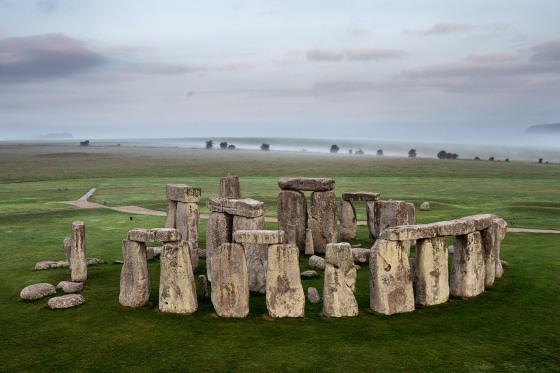The Summary
- The "altar stone" at the center of Stonehenge most likely originated in present-day Scotland, a study found.
- That's more than 450 miles away, raising questions about how ancient humans transported the stone such a long distance.
- The study's authors suggest they may have used boats.
Scientists say they’ve cracked a secret of the 6-ton rock at the center of Stonehenge — a discovery that only deepens the site’s mystery. The ancient monument’s “altar stone,” a sandstone rock at its center, likely originated in present-day Scotland, according to a study published Wednesday in the journal Nature. That means it was hauled more than 450 miles to southern England — significantly farther than any other stone at Stonehenge with known origins.
The finding raises profound questions. The researchers suspect the altar stone was installed about 4,500 years ago, which means that Neolithic people were able to move the rock hundreds of miles — long before lightweight, spoked wheels were invented.
The revelation also suggests that cultural and social structures were more interwoven in the British Isles at the time than previously realized, and that Neolithic people were capable of executing complex projects with relatively simple tools.
The discovery was based on an analysis of the age of mineral grains within the sandstone rock. After profiling the grains’ ages, the researchers were able to compare the altar stone’s age “fingerprint” to a database of sandstone samples across Britain and in nearby locations like Brittany, France.
“With quite a high degree of statistical certainty, in fact, bigger than 95% confidence, we can associate the age spectra to a very specific area in northeast Scotland,” said Chris Kirkland, a co-author of the study and a professor of Earth and planetary sciences at Curtin University in Australia.
The region Kirkland was referring to, the Orcadian basin, includes the Orkney islands, which are themselves known for elaborate stone circles.
“The specific reason why this material was transported, we can’t really answer that directly,” Kirkland said. “All we know is it’s a 6-and-a-half-ton piece of rock that’s come from 750 kilometers away. That, by itself, tells us an awful lot about Neolithic society and its connectivity.”
Stonehenge — a UNESCO World Heritage location and one of the best preserved prehistoric megalithic monuments — is encircled by large sandstone tablets called “sarsens.” These, in turn, support stone lintels — horizontal spans also made of rock, some of which are slotted together with joints. Inside the sarsen outline is an inner circle of “bluestones” with an additional horseshoe shape inside that circle.
The sarsens are thought to have originated about 15 miles north of the Stonehenge site, while the bluestones were sourced from Wales, about 140 miles away.
The new study pertains to the altar stone in the middle: a tablet-shaped rock about 16 feet long, which shows evidence of being shaped by human tools. Other Stonehenge tablets are now on top of the altar rock, apparently toppled by time.
“It’s a special stone for whatever reason,” said David Nash, a professor of physical geography at the University of Brighton, who has studied Stonehenge but was not involved in the new research. “It’s a very different stone to all of the other stones at the monument.”
Kirkland and his fellow researchers examined three ways the altar stone could have traveled from Scotland to Stonehenge. The first is that it was carried by glacial ice movement during the Ice Age, but the study authors don’t think that’s the right explanation. The second is that humans moved it over land, but the team suspects the forested terrain would have been too challenging.
The third option, which they think is most likely, is that the stone was transported by boat. There is evidence of maritime shipping around this time period — when present-day England had a different shoreline.
Nash said the authors had come to “sound conclusions” about the altar stone’s origin.
“What they’ve done is really interesting,” he said, adding that their findings bolster evidence that Neolithic people traveled throughout the British Isles and were part of a broad social fabric. “There’s clearly social structures, there’s connections, there’s very clear communication of ideas.”
Stonehenge is one of about 1,300 ancient stone circles in existence, according to the British Museum. Researchers think the site’s stones were shaped by hand tools and erected with winch and pulley systems. They are arranged to align with the movements of the sun and summer and winter solstices.
Experts suspect Neolithic people used these sites for ceremonies or rituals, but the details are lost to time. What, in particular, made the altar stone special is unclear.
“Millionaires today adorn their mansions with Carrara marble from Italy, and I’ll never understand why they do that, so it’s just a mystery,” said Anthony Clarke, the lead author of the new study and a doctoral student at Curtin University. “Humans have always had a fascination with finding the perfect rock, and maybe the Neolithic Britons are the same, so their motivations are lost to time.”
The researchers said that as a next step, they hope to pinpoint the exact outcropping or region where the rock originated, but the fundamental riddle will likely remain.
“They put some great value in bringing that stone 700, 800, 900 kilometers,” said Nick Pearce, another co-author of the study and a professor of geography and Earth sciences at Aberystwyth University in Wales. “However they brought it, it meant something to them. What did it mean? Why did it mean that much to them? It gives us all something to ponder.”
